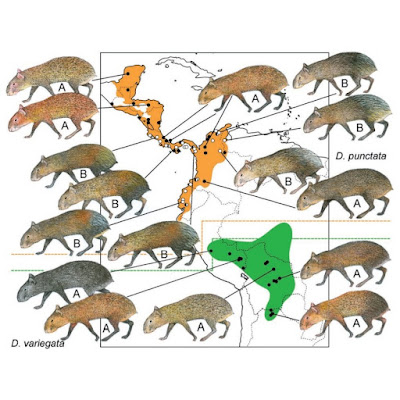[Most Recent Entries] [Calendar View]
Tuesday, October 19th, 2021
| Time | Event | ||
| 7:52a | [Botany • 2021] Symplocarpus koreanus (Araceae: Orontioideae) • A New Species based on Morphological and Molecular Data from Korea
Abstract Symplocarpus koreanus (Araceae; Orontioideae) from Korea is described as new. Symplocarpus koreanus has long been considered to be conspecific with S. renifolius in Japan, but phylogenetic, morphological, and cytological data indicate its taxonomic distinction. Compared to S. renifolius, S. koreanus has a much smaller spathe and more spherical spadix with fewer, smaller flowers. Previous phylogenetic studies also suggested that S. koreanus is more closely related to nonthermogenic S. nipponicus than to S. renifolius in Japan. Like its nonthermogenic sister species, S. nipponicus, in Korea and Japan, S. koreanus is diploid (2n = 2x = 30), while S. renifolius in Japan is tetraploid (2n = 4x = 60). A detailed species description, geographical distribution, major morphological differences between the species and a dichotomous key to the species in eastern Asia are provided. Keywords: Araceae, Orontioideae, Symplocarpus koreanus, Korean endemic, Korean skunk cabbage Symplocarpus koreanus J. S. Lee, S. H. Kim & S. C. Kim, sp. nov. Etymology: The specific epithet, koreanus, is based on the name of the country of origin, Korea. Vernacular name: Han-guk-an-jeun-bu-chae (한국앉은부채). English colloquial name: Korean skunk cabbage. Joon Seon Lee, Seon-Hee Kim, Yongsung Kim, Youl Kwon, JiYoung Yang, Myong-Suk Cho, Hye-Been Kim, Sangryong Lee, Masayuki Maki and Seung-Chul Kim. 2021. Symplocarpus koreanus (Araceae; Orontioideae), A New Species based on Morphological and Molecular Data. Korean J. Pl. Taxon. 51(1): 1−9. DOI: 10.11110/kjpt.2021.51.1.1 | ||
| 3:41p | [Mammalogy • 2021] Uncovering Species Boundaries through Qualitative and Quantitative Morphology in the Genus Dasyprocta (Rodentia, Caviomorpha), with Emphasis in D. punctata and D. variegata Abstract The genus Dasyprocta Illiger, 1811 includes at least 13 species of medium-sized caviomorph rodents, widely distributed from Mexico to northern Argentina. Despite being abundant, largely diurnal, and easily identifiable by their external traits, the taxonomy of this genus remains poorly understood. In this work, we reviewed the taxonomy of Dasyprocta along the Andes and adjoining lowland areas of the western Neotropics, including samples from Mexico to northern Argentina, with emphasis on two species largely confounded—sometimes considered as synonyms—during the last century: D. punctata Gray, 1842 and D. variegata Tschudi, 1845. In the construction of our taxonomic hypotheses, we use a purely morphological approach, emphasizing qualitative and quantitative cranial features and external traits (color patterns). The results of multivariate statistical analysis and differences in color patterns support the species-level validity of D. punctata and D. variegata. Within this latter nominal form, we also include those populations from northern Argentina and eastern Bolivia that recently were referred to D. azarae. Based on our results, D. punctata (including bellula, callida, candelensis, chiapensis, chocoensis, colombiana, dariensis, isthmica, nuchalis, richmondi, underwoodi, yucatanica, and zuliae) extends from southern Mexico to Colombia, Ecuador, northernmost Peru, and western Venezuela, while D. variegata (including azarae, boliviae, and yungarum) is distributed from south–central Peru and southwestern Brazil to Bolivia and northwestern Argentina. Keywords: agouti, Cavioidea, Caviomorpha, Dasyprocta, Dasyproctidae, taxonomy Pablo Teta and Nicolás Reyes-Amaya. 2021. Uncovering Species Boundaries through Qualitative and Quantitative Morphology in the Genus Dasyprocta (Rodentia, Caviomorpha), with Emphasis in D. punctata and D. variegata. Journal of Mammalogy. gyab101. DOI: 10.1093/jmammal/gyab101  El género Dasyprocta Illiger, 1811 incluye al menos 13 especies de roedores caviomorfos de tamaño mediano, ampliamente distribuidas desde México hasta el norte de Argentina. A pesar de ser abundantes, mayormente diurnas y fácilmente identificables por sus rasgos externos, la taxonomía de este género sigue siendo poco clara. En este trabajo, revisamos la taxonomía de Dasyprocta a lo largo de los Andes y tierras bajas adyacentes del Noeotrópico occidental, incluyendo muestras desde México hasta el norte de Argentina, con énfasis en dos especies largamente confundidas (a veces consideradas sinónimos) durante el siglo pasado: D. punctata Gray, 1842 y D. variegata Tschudi, 1845. En generar nuestra hipótesis taxonómica utilizamos exclusivamente métodos morfológicos, enfatizando características craneales cualitativas y cuantitativas, así como rasgos externos (patrones de color). Los resultados del análisis estadístico multivariado y las diferencias en los patrones de color respaldan la distinción a nivel de especie entre D. punctata y D. variegata. Dentro de esta última forma nominal incluimos las poblaciones del norte de Argentina y este de Bolivia que fueron referidas recientemente como D. azarae. Según nuestros resultados, D. punctata (incluyendo bellula, callida, candelensis, chiapensis, chocoensis, colombiana, dariensis, isthmica, nuchalis, richmondi, underwoodi, yucatanica y zuliae) se extiende desde el sur de México hasta Colombia, Ecuador, norte de Perú y oeste de Venezuela, mientras que D. variegata (incluyendo azarae, boliviae y yungarum) se distribuye desde el centro-sur de Perú y el suroeste de Brasil hasta Bolivia y el noroeste de Argentina. agouti, Cavioidea, Caviomorpha, Dasyprocta, Dasyproctidae, taxonomía |
| << Previous Day |
2021/10/19 [Calendar] |
Next Day >> |


